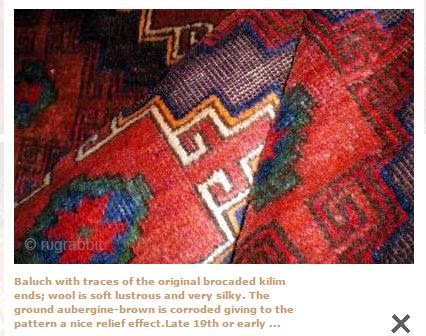 |
| First half 20th Century Mashhad Rug |
I came across a recipe for using Lac as a dye in a book from
1907. It helps me to understand things I have observed about Lac without truly
understanding. Let us look at the dye Lac as I understand it:
Lac is one of the oldest insect dyes used in Oriental rugs. Mark
Whiting in Hali Magazine (Vol.
1. 1978) wrote that the insect dye lac was the principal red dye used in
classical Persian carpets. Of 20th century production it is a defining
feature of Mashhad rugs.
Lac traditionally was raised in Northern India and is a
resin secreted by the lac insect (Laccifer lacca) upon the smaller branches of
trees, including the soapberry, acacia and the fig tree. Lac takes it's name
from the word for 100,000 - lahk which refers to the huge number of insects who
are needed to make marketable quantities of Lac. Stick lac is when the lac
is still on the branch and grain lac is when it has been crushed and
washed.
Use of lac yields a "cool" bluish red rather than the brilliant
insect reds in the blue tones that we associate with cochineal. I have had
a distinct impression that Lac dyed wool is not as long wearing as madder dyed
wool and more prone to breakage. Frankly I assumed that it was akin to the
fragility of shellac 88 rpm records that I remembered from my childhood. If you
remember if you dropped a vinyl LP it might scratch but it was unlikely to
break. Shellac records on the other hand would shatter if dropped. So when I saw
the propensity to wear more quickly I assumed it was an attribute of the
shellac. But then I found this recipe from 1907:
For 40 pounds of goods make a tolerably thick paste of Lac
dye and sulphuric acid and allow it to sit for a day. Then take tarter 4
pounds, tin liquor 2 pounds 8 ounces and 3 pounds of the paste. Make a hot bath
with sufficient water and enter the goods for ¾ hours; afterwards carefully
rinse and dry.
From
From
Henleys' Twentieth Century Book of Recipes, Formulas and
Processes, edited by Gardner Dexter
Hiscox
The Book is also known as:
Henley's twentieth century formulas recipes and processes
containing ten thousand selected household and workshop formulas recipes
processes and money-saving methods for the practical use of manufacturers
mechanics housekeepers and home workers. By Gardner Dexter Hiscox, editor.
The use of Sulfuric Acid in the dye bath suggests to me that the shorter life of Lac dyed wool may have more to do with the Sulfuric Acid them with the Lac.
The use of Sulfuric Acid in the dye bath suggests to me that the shorter life of Lac dyed wool may have more to do with the Sulfuric Acid them with the Lac.



























.jpg)














